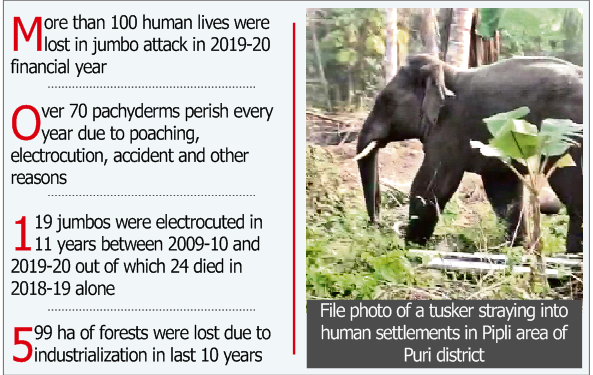Bhubaneswar: Over the years, human beings have virtually overtaken and captured the habitats of animals. As a result, the incidents of human-animal conflict have become a day-to-day affair. The trend will continue until there is proper plan in place to protect the habitats of wild animals, wildlife experts say.
Recently, a wild elephant went on rampage killing at least four persons and critically injuring three others in Puri district.
Similarly, in January this year, around 600 schools in three blocks of Jajpur were closed for some days after an elephant killed two persons in the district.
In another case, over a dozen were injured following an attack by a troop of monkeys at a village in Kendrapara. The simians also ravaged farmlands at Badamangarajpur under Derabish block.
The man-elephant conflict was at its worst towards the end of the 2019-20 fiscal year as more than 100 human lives were lost in jumbo attack. At the same time, more than 70 pachyderms perish on an average due to poaching, electrocution, accident and other reasons.
As per the data, at least 11 elephants are electrocuted every year in Odisha. Data from the Forest and Environment department has revealed that 119 jumbos were electrocuted in 11 years between 2009-10 and 2019-20 out of which 24 died in 2018-19 alone.
The State of the World’s Forests 2016 report by FAO revealed that 7 million hectares of forest cover is lost annually due to agricultural land expansion, mining, industries, human settlement and other development programmes.
In Talabira area in Sambalpur, thousands of trees were felled to make way for a coal mine despite protests by the tribal villagers and environmentalists.
Forest and Environment Minister Bikram Keshari Arukha said in the Assembly this year that Odisha has lost about 599 hectares of forest land in last 10 years due to industrialisation. The minister said that total forest area in the state was 58,136 sq km in 2011, but reduced by about 599 hectares till 2019.
As per the data of Ministry of Environment and Forest, three eastern States of India— Odisha, West Bengal and Assam contribute to about half the human- elephant fatalities. As per the data West Bengal had the highest number of human casualties: 403, followed by Odisha with 397 and Assam with 332 deaths in last five years (2014-15 to 2018-19)
Odisha Environmental Society secretary Jaya Krushna Panigrahi emphasised on maintaining the wilderness of the forest ecosystems and batted for involvement of all stakeholders in the conservation initiatives. According to him, habitats of wildlife are degrading and declining as a consequence of human activities. Non-availability of required food and water, in addition to shrinkage of habitats and disappearance of corridors, forces the wild animals including elephants to come out of the natural habitats, said a few experts.
According to the experts, elephants are attracted by paddy and vegetables, cultivated close to forestlands. They advocated for the formulation of a long-term plan to deal with the situation.
In a bid to reduce man-elephant conflict, the state government had identified 14 elephant corridors in Odisha for safe movement of the pachyderms which frequently come out of their habitat in search of food and water. Panigrahi, however, said that the authorities concerned are yet to implement the corridor plans. “Creating elephant corridors by linking fragmented forests through plantation is a time-consuming and arduous task that needs displacement of human habitations, industries, railway tracks, roads and canals,” Panigrahi said.
Animal activist and founder of Animal Welfare Trust Ekamra Purabi Patra said unless the government defines a boundary between the wildlife and urbanisation, nothing will change. “We can’t expect a ‘no human-animal conflict’ situation after encroaching upon their habitats. Forests are being converted into farmlands by villagers. Where do you expect the wild animals to go for their food and shelter? The incidents of animal attack are quite common due to this reason,” Patra added.
Wildlife expert Jiban Ballav Das said, “We are destroying their home, food and corridor which force them to come to the human settlements. The government should take initiative to protect their habitats otherwise this man-animal conflict will never end. Elephants do not leave their corridors. Many of their corridors have been destroyed by human interference. Development should be done in a planned manner so that both elephants and human beings remain safe and co-exist peacefully.”
Kusal Biswas of Speak for Animals (SFA) said the migratory routes of the elephants have been affected by deforestation and urbanisation. As a result, there is conflict between humans and elephants. “Elephants are the pride of Odisha. They are also an endangered species. The government has failed to create awareness on elephants among people and recruit trained staff to protect wildlife,” Biswas added.
In a bid to reduce the man-animal conflict, the Forest and Environment department has decided to plant fruit-bearing trees in more than 500 hectares of land under the Compensatory Afforestation Fund Management and Planning Authority (CAMPA) programme for which Rs 803.65 crore has been approved for 2020-21 fiscal.
Principal Chief Conservator of Forests (Wildlife) and Chief Wildlife Warden (CWW) Hari Shankar Upadhyay said that the department will take up fodder plantation on 1,250 acres of land to prevent elephants from straying into human settlements in search of food.
Arindam Ganguly, OP






































